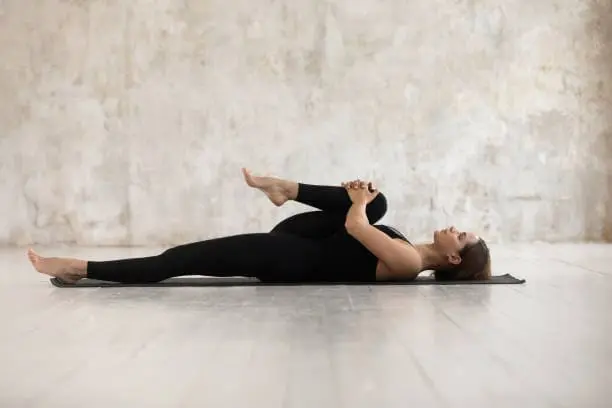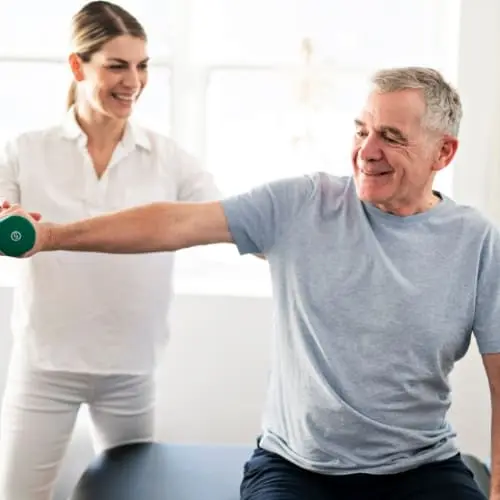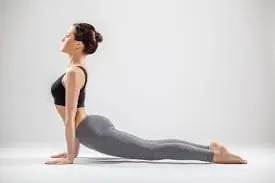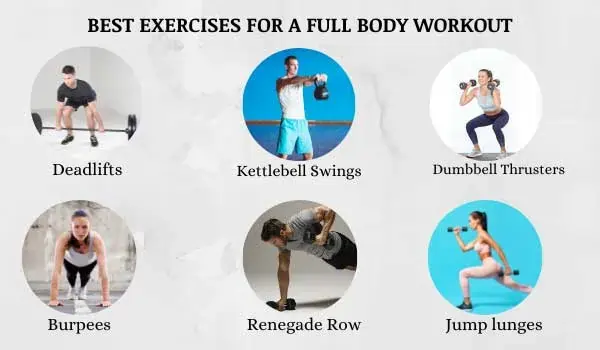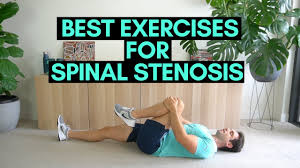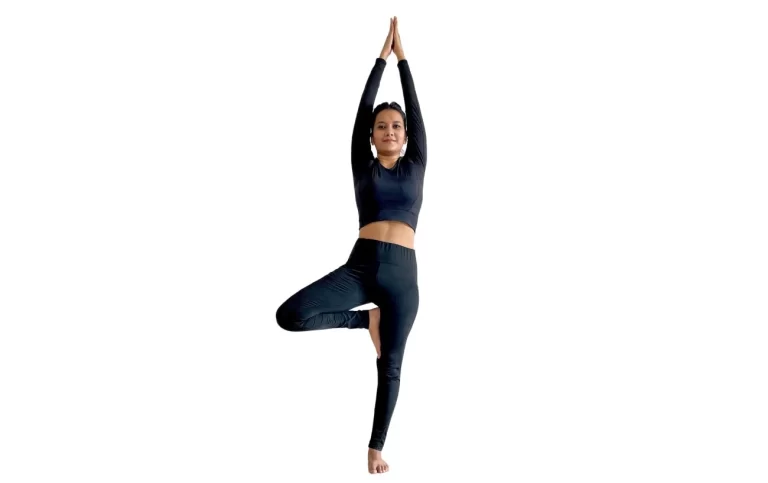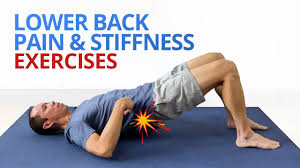16 Best Exercises for Lumbar Spinal Stenosis
Exercises for Lumbar Spinal Stenosis is necessary for symptom management and improved overall function.
Exercises for lumbar spinal stenosis have been created to improve flexibility, strengthen supporting muscles, and promote spinal stability. Low-impact aerobic workouts like walking, swimming, and cycling can help increase cardiovascular fitness without putting too much strain on the back.
Stretching exercises for the lower back, hips, and thighs can increase flexibility and minimize muscle tension. Core-strengthening activities, such as mild stomach and back workouts, can help stabilize the spine and improve posture.
To create an exercise plan that is customized to your unique condition and skills, you must speak with your doctor or physical therapist. They can offer proper guidance and guarantee that the workouts are being done safely and correctly.
Exercise and physical therapy will improve blood flow to the stenosis area, removing harmful metabolites and delivering necessary nutrients and oxygen. By maintaining the muscles around the spine strong, exercise releases pressure from the nerve roots, bones, and other stationary structures in the back.
A medical condition known as lumbar spinal stenosis develops as the spinal canal narrows, compressing the lower back’s spinal cord and nerves. This may result in lower back, buttocks, and leg pain, numbness, weakness, and other symptoms.
What is Lumbar Spinal Stenosis?
When the space inside the lower backbone is too small, it results in lumbar spinal stenosis. Compression of the spinal cord and nerves passing through the spine may result from this. The lower back is where spinal compression typically happens. Not everyone with lumbar spinal stenosis shows any symptoms. Others might experience muscle weakness, tingling, pain, and numbness. Over time, symptoms have the potential to worsen.
Stenosis is mostly caused by variations in the wear and tear of the spine caused by arthritis. Patients with severe spinal stenosis can need surgery. Extra space within the backbone can be created via surgery. By doing this, the symptoms caused by pressure on the nerves or spinal cord can be reduced. Although arthritis cannot be treated with this method of treatment, back pain from the condition might return.
Causes:
- Tumors
- Arthritis
- Trunk injuries
- Bone spurs
- Herniated disks
Signs and symptoms:
While symptoms vary between individuals, the following is the typical appearance;
- Prolonged standing causes increased pain.
- There is pain in one or both lower limbs.
- Back pain
- Bending forward changes the sensory or muscular power of the legs.
- Leg numbness, tingling, cramping, or weakness
- Loss of sensation in the feet
- Pain decreases as you sit, lean forward, or walk uphill.
The Advantages of Exercise:
- Exercise will improve blood flow to the injured area, removing toxic metabolites and delivering necessary nutrients and oxygen.
- By strengthening the muscles close to the body, exercise can relieve pressure on the back’s bones and other static designs.
- Exercise can help avoid tense muscles that strain and twist the spine, which can worsen the signs of spinal stenosis.
- A healthy weight can be maintained with training. Gaining weight could lead to leg and back problems.
- Keeping active also benefits mental and emotional well-being. Elevating oneself and exerting force releases endorphins and blood, improving the state of mind and reducing pain and health problems.
Before beginning a routine of exercise, take the following steps:
To get the most benefits of any workout program and minimize risks, there are a few things to think about before starting. Consult a physician or physical therapist for guidance on the most effective exercises for your particular issue.
It’s important to pay attention to your health and avoid pushing through challenges. While some stiffness is common after exercise, chronic or severe pain may indicate that you’re exerting yourself too much. You should start with low-impact exercises and work your way up to more difficult ones as soon as you can.
Maintaining correct form and technique is important to prevent additional injuries. See a physical therapist if you have any questions about how to put out your exercise routine correctly. Warm up your joints and muscles before beginning any activity to help them get ready for the workout.
Exercises for Lumbar Spinal Stenosis:
Lumbar spinal stenosis patients may find that doing specific exercises can reduce pain and increase their range of motion. Exercises that strengthen your core Particularly target the muscles that support your spine, relieving pressure and improving flexibility. Physical activity additionally increases blood flow to the area, which helps reduce symptoms.
Single knee to chest
- Begin by laying flat on your back, putting your feet flat on the floor, and bending your knees.
- Put your hand just below your kneecap or behind your knee.
- Now raise your knee to your chest.
- Hold it for a few seconds.
- Slowly let your leg go down.
- Then return to your neutral position.
- Next, relax.
- Do this five to ten times over.
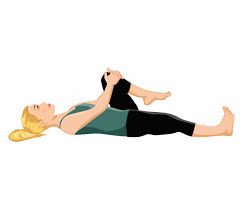
Double Knee to Chest
- Lying flat on your back, place your feet level on the floor and bend your knees. We refer to this as the supine position.
- Raise one knee to your chest, then raise the other one. Never raise both of your legs at once.
- As much as you can, attempt to relax your lower back, pelvis, and legs while you’re pulling.
- Hold this position for a few seconds.
- Put your leg back on the ground.
- Then return to your neutral position.
- Next, relax.
- Do this five to ten times over.
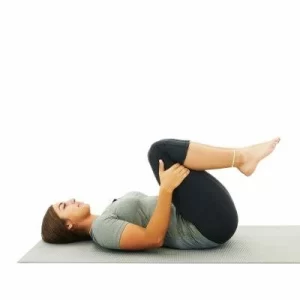
Lower Trunk Rotation
- It is comfortable to begin by lying on your back.
- Bend your knees on both sides.
- Keep your feet flat on the floor.
- Take a deep breath in.
- Keep your shoulders firmly planted in the earth.
- Lean forward on one knee.
- Look over there on the other side.
- Hold it for a few seconds.
- Then, return to your neutral posture by taking a single step at a time.
- Next, relax.
- Do this five to ten times over.
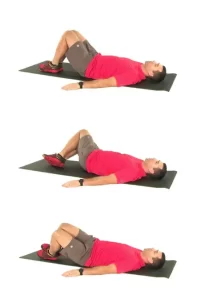
Pelvic tilt
- Start with relaxing while lying down on the bed or table.
- Now bend your knees.
- Place your hands on your chest or at your sides.
- The muscles in your abdomen should be tight.
- Hold it for a few seconds.
- Then return to your neutral position.
- Next, relax.
- Do this five to ten times over.
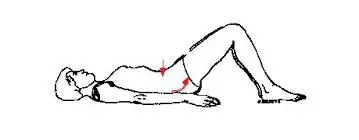
Seated spinal twist
- Both of your legs should be extended in front of you as you take a comfortable seat on the floor.
- Then, place your bent left knee flat on the outside of your right thigh.
- At this point, extend your right arm over your left leg.
- Put your hand behind you.
- Very carefully, turn your body to the left.
- Hold it for a few seconds.
- Then return to your neutral position.
- Next, relax.
- Do this five to ten times over.
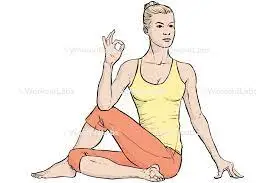
Front plank
- To start, place your hips under your knees and your shoulders below your wrists.
- Make a long line with your body by straightening one leg before the other and putting your toes under your feet.
- Pay attention to your core and abdomen to pull your body so that it doesn’t break down.
- People often bend or lift their hips excessively in an attempt to improve their comfort level.
- The intention behind a strong, straight line.
- One way to make sure proper form is to practice in front of a mirror or with another person.
- Hold it for a few seconds.
- Then return to your neutral position.
- Next, relax.
- Do this five to ten times over.
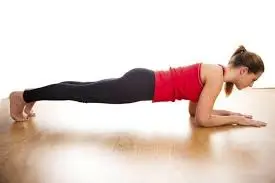
Side plank
- With your legs extended straight from your hips to your feet, lie on your right side.
- Your right arm’s elbow is located straightaway below your shoulder.
- Verify that your head and spine are in a straight line.
- Your left arm and left side of the body should be adjusted.
- Contraction of the abdominal muscles happens as the belly button retracts toward the spine.
- Breathe out as you lift your hips and knees onto the mat.
- Your body has no bending or dropping in any direction.
- Hold it for a few seconds.
- Then return to your neutral position.
- Next, relax.
- Do this five to ten times over.
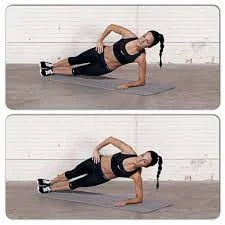
Partial sit-ups
- For this exercise, you must lie on your back with your legs bent and your hands by your sides.
- Use your abdominal muscles to raise your upper back off the floor while you continue to breathe.
- Raise your shoulders off the ground by just a little.
- Don’t push yourself off the base or raise your head.
- Feet should be flat on the ground and knees should stay bent.
- The only muscles contracting should be your stomach muscles.
- Gently lower your upper body.
- Then return to your neutral position.
- Next, relax.
- Do this five to ten times over.
- Proceed with light and fluid movements.
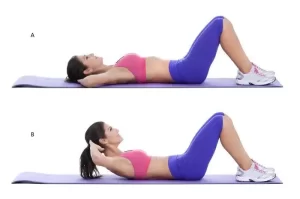
Seated lumbar flexion
- With your feet flat on the ground and your knees open, take a seat in a chair.
- Bend your lower back as you lean forward.
- Reach down and plant your hands on the ground in the space between your knees.
- Hold this position for a few seconds.
- Then return to your neutral position.
- Next, relax.
- Do this five to ten times over.
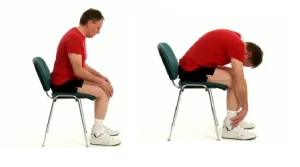
Standing quadriceps stretch
- If you need assistance, use a chair or a wall nearby and stand tall.
- Bend your right knee and shift your weight to your left leg.
- As you balance on your left leg, maintain your balance.
- With your left hand, gently push your foot up to your butt by grabbing your right ankle.
- Your quadriceps should feel stretched down the front of your right thigh.
- Hold your chest up straight and your back straight.
- To make the stretch deeper, you can slightly tilt your hips forward.
- Hold this position for a few seconds.
- Then return to your neutral position.
- Next, relax.
- Do this five to ten times over.
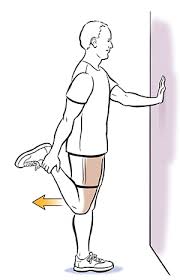
Standing Lumbar Flexion
- Place your feet apart as you stand.
- Bend forward slowly and extend your hand toward the ground.
- Hold for a few seconds once you are completely bowed.
- Then return to your neutral position.
- Next, relax.
- Do this five to ten times over.
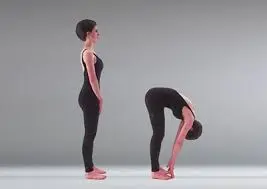
Bridge
- Position your feet flat on the floor and lie flat on your back.
- Check that your thighs are parallel to one another and that your toes are pointed straight forward.
- Lift your upper body.
- Kindly keep your arms at your sides.
- For the full exercise, make sure your knees stay over your toes.
- Hold this position for a few seconds.
- Let your hips return to the ground in a smooth motion.
- Then return to your neutral position.
- Next, relax.
- Do this five to ten times over.
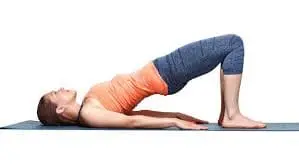
Side-lying leg raise
- Start on the platform in a relaxed side-lying position.
- Ensure that your legs remain straight at all times.
- Now, without moving the rest of your body, raise one leg straight up.
- Hold this position for a few seconds.
- Lower your leg.
- Then return to your neutral position.
- Next, relax.
- Do this five to ten times over.
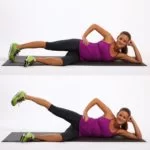
Hamstring stretch
- You should lie on your back.
- Secure the bottom of your foot with a belt or strap.
- Use the strap for pulling your leg in the direction of your head if you are unable to touch your toes.
- As an alternative to using your toes, you can instead grasp the area of your leg above your foot.
- Leg raised, straight or slightly bent, contract your stomach muscles.
- To help with hamstring stretching, gently pull on the band.
- Hold this position for a few seconds.
- Leg down gradually after releasing the band.
- Then return to your neutral position.
- Next, relax.
- Do this five to ten times over.
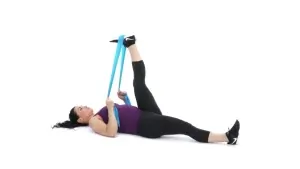
Walking
- Most people can benefit from walking as a form of exercise.
- If you have spinal stenosis, it is low-impact and you may simply adjust the speed to suit your needs.
- Think about going for a daily walk (maybe just after you come home or during your lunch break).
- Walking outside may be pleasant, and it’s the ideal way to relax after a long day.

Swimming
- Another excellent exercise is swimming, which trains every muscle in your back in a supportive and safe environment.
- There’s less weight on your back because the water supports your weight well.
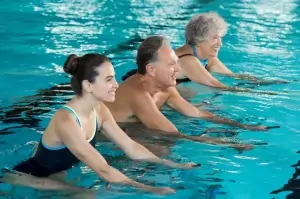
Which safety precautions need to be followed when working out?
Exercise should be done correctly and securely, considering your particular
conditions. Exercising only after speaking with a doctor or physical therapist is best.
- Stretch and warm up before working out.
- Maintain proper posture during the activity.
- Avoid strenuous workouts.
- If working out is uncomfortable for you, stop.
- In between sets of exercises, rest.
- Stretching before, holding in between, and completing the right amount of repetitions for each exercise are all part of the protocol that should be followed when performing any exercise.
- When working out, stay away from wearing tight clothing and dress comfortably so that your body can move freely.
- When you stretch the tight muscle, it’s fine if it hurts. However, you shouldn’t experience any sudden, sharp pain while stretching.
- Holding your breath while exercising is never the right thought. It’s recommended that you take deep breaths and exhale them gradually through your mouth when exercising. Holding your breath while exercising causes your muscles to stiffen up more, which raises your risk of high blood pressure.
When do you not work out?
- A burning sensation in the muscles
- You don’t feel good.
- If any pain or numbness is experienced.
- Fever
- Stop working out if it pains you.
Which workouts should you avoid if you have lumbar canal stenosis?
- Stay away from Overly Extended Back Extension
Leaning backward when standing puts additional strain on your spine if you have stenosis. The way you maintain a straight posture when you lean forward and place your hands on your hips is affected. This type of stenosis on the back of the vertebrae can also help in the release of some inflammatory tissue to allow the spinal cord to have extra space.
Still, it presents with more painful signs and dangerous effects in many cases. Avoid exercises that put your back through severe extension or that cause you pain or irritation. More importantly, attempt to avoid any movement that puts your back through extreme extension. i.e. anything that requires you to bend backward. Because of the increasing stenosis, inflammation may worsen.
- Avoid Contact Activities
Even while being active is still beneficial, it’s a good idea to engage in activities that reduce excessive pressure and contact. Sports like soccer, football, basketball, and martial arts are among those where participating in a healthy activity can quickly result in a major break or fracture, especially if you come into touch with someone else.
- Avoid Loading a Rounded Back
Using free weights can be quite helpful for people with backaches, and with a doctor’s guidance, they can begin exercising. By building muscle, a range of workouts helps support the spine while improving comfort in preserving good posture. Free-importance activities can also help you achieve better unilateral posture, which includes differentiating the strength in your arms, legs, hips, and shoulders. This might help avoid additional back issues.
Exercises using free weights, however, might be dangerous if done improperly. Any exercise that calls for hip hinging, including deadlifts, bent-over rows, and passes, is one example of this. Any curvature of the back could place the discs under shearing strain and significantly compromise the strength of the muscles supporting the spine. Remember to complete each exercise one at a time and maintain your confidence as you move through the exam to avoid overstretching your back.
- Avoid Specific Poses and Stretches
The previously mentioned back extension is a component of many common postures and exercises for spinal stenosis, such as the cobra pose, as well as numerous lower back exercises that stress hyperextension, such as the Superman. Although it is a good idea to support the muscles of the lower back, it is recommended to avoid lumbar flexion or extension when doing so. Instead, think about isometric exercises, which involve stabilizing and tightening the back against an outside stimulus.
- Stay away from long runs or walks
Many activities are important for people with spinal stenosis, but doing too many or incorrect ones could worsen your symptoms. Jogging and running are generally regarded as low-impact, relaxing forms of exercise. Jogging and running, on the other hand, are classified as high-impact exercises.
Compared to other body parts, the spine and knees are less at risk for repetitive concussions. Conversely, walking overly long distances may make back pain worse. Start with shorter, more manageable distances to gradually increase pace and distance without going into a jog.
- Stay away from prolonged bed rest
Even if the argument for staying in bed as much as necessary may be strong, spending too much time in bed can weaken your muscles, strain your back, and increase inflammation. By leading an active lifestyle, you can improve your quality of life and reduce pain with a little daily investment of time spent moving and getting sweaty.
Lifestyle modifications:
You might change your life with these common variations;
- Remember not to put undue tension on your lower back as you proceed forward.
- Modify your position frequently.
- Avoid sitting down too much.
- Stay away from the positions that cause you pain.
- Regular exercise practice.
- Control your weight.
- Make an effort to maintain a straight posture.
Which Posture Worsens Lumbar Spinal Stenosis?
Managing your daily tasks might feel like being on a balance beam when you have spinal stenosis. While some postures can help relieve your symptoms, others could aggravate your condition. Knowing which positions to avoid is important for managing symptoms and preventing further injury.
The spaces inside your spine constrict with spinal stenosis, which can put pressure on the nerves that pass through it. This problem is known as lumbar stenosis when it affects the lower back, and certain body positions can make the pain and suffering worse.
Generally speaking, bending backward or extending the spine can cause pain. This posture may put further strain on already severely compressed neural systems. If you suffer from lumbar stenosis, you should try to prevent arching your back.
On the other hand, leaning forward somewhat widens the gaps between the vertebrae where nerves leave the body, which may provide some pain relief. Staying committed to this posture is neither practical nor advantageous for the general health of the spine, though.
Lying flat on your back without sufficient support below your knees is another position that can aggravate the symptoms of spinal stenosis. Though this pose may look peaceful, the unsupported curve in your lumbar region may unintentionally put more strain on your lower back.
Another typical cause is sleeping in an unnatural position. Often, people are not aware that the way they sleep at night may be causing them trouble throughout the day. To help keep your spine in a neutral position when you’re lying down, use supportive pillows and mattresses.
Putting it all together these observations;
- Do not bend backward too far or too long.
- Maintaining a hypertension posture
- Yoga poses or stretches that involve backward bends
- Watch how you sleep; don’t lie down flat on your back or your knees.
- Using pillow and mattress supports, make sure your spine is properly aligned.
It is possible to move quickly during the day without worsening spinal stenosis symptoms if you are aware of these postural traps. Your body will often tell you what is comfortable for you, so always think about making soft movements and pay to follow its signals.
Summary:
Vertebrae, or the bones that make up your spinal cord, contain nerves. More pressure or irritation is placed on these nerves when gaps inside the spinal cord narrow, a disease known as spinal stenosis. This condition can cause lower back pain and stiffness as well as tingling or numbness down one or both legs.
Exercise can help manage the symptoms of lumbar spinal stenosis and stop the condition from getting worse. To begin your home exercise program for lumbar spinal stenosis as soon as possible, schedule an appointment with your physical therapist to learn exercises that fit your situation.
Exercise can help you stay active by increasing your strength and flexibility.
FAQ:
What exercise is best for individuals with lumbar stenosis?
If you have spinal stenosis, walking is the best exercise for lumbar stenosis. This is a low-impact workout that you can easily adjust the pace to suit your needs. Take a daily walk (maybe right after you get home or during your lunch break).
Is spinal stenosis better treated with heat or cold therapy?
One typical recommendation for pain management in spinal stenosis is to use either hot or cold therapy. Warm therapy promotes blood flow to the affected area and helps to relax muscles, helping in the healing process. Ice therapy can help numb the affected area, which will relieve pain.
What kind of issues does a person with spinal stenosis usually face?
If you have lumbar spinal stenosis, you may find it difficult to walk for extended periods or you must bend forward to relieve pressure on your lower back. Your lower limb may hurt or go numb. If it gets worse, you can have trouble managing your urine and bowel movements.
How is stenosis prevented?
By preserving the muscles and ligaments that support your spine and stretching them to help maintain your flexibility, exercise can help control stenosis. Maintaining proper posture when walking for fifteen minutes a day is an excellent strategy to keep your back in shape.
For spinal stenosis, what is harmful?
Extensive Extension of the Back
The standing back extension, or more thoroughly, the standing lumbar extension, is one of the more common stretches we can perform following an extended time of sitting or bending over. It involves directly standing up, putting your hands on your hips, and bending back as far as you can.
Which causes stenosis the most frequently?
Arthritis-related wear-and-tear alterations in the spine are the most likely cause of spinal stenosis. In extreme cases, individuals with severe forms of spinal stenosis may require surgery. More space within the spine may form after surgery. This may lessen the pain caused by pressure on the nerves or spinal cord.
Without surgery, how may lumbar spinal stenosis be improved?
Painkillers and physical therapy are examples of nonsurgical treatments that many people with mild spinal stenosis find to help them manage their symptoms and continue their level of activity.
In this situation, what is the ideal sitting posture?
Bending forward, especially while sitting, usually causes little pain for people with spinal stenosis. Improved space for the nerves can be achieved by bending forward, according to lumbar spine analyses.
Is It Possible to Stop the Worsening of Your Spinal Stenosis?
As difficult as it may be to live with spinal stenosis, there are things you can do to keep it from getting worse. Knowing which actions make the problem worse is essential. One way to better control your symptoms and prevent your spinal channels from restricting more is to avoid specific actions and workouts that put stress on your spine.
When lumbar spinal stenosis is present, which activities should one avoid?
Running
Jumping
Contact Sports
Long Walks
Back Extensions
For spinal stenosis, what kind of physical therapy works best?
Stretching and Range-of-Motion Exercises
Strengthening Exercises
Use of Equipment
Postural Instruction.
Which sitting posture is ideal for someone with spinal stenosis?
When seated, maintain both feet flat on the floor, prevent bending forward, and ensure that your lower back is properly supported.
Which sleeping posture is ideal for those with spinal stenosis?
It can be better to sleep on your sides with your knees bent (fetal position) if you have this disease. By doing this, pressure on the nerve root is reduced. The nerve can also be relieved by sleeping in a recliner chair or an adjustable bed that keeps the knees and head up.
Can physical activity help with spinal stenosis?
Exercise can help relieve nerve compression and improve symptoms like pain and disability in patients by increasing the activation of paravertebral muscles, improving the stability and coordination of the lumbar spine, improving the lumbar lordosis angle, and adjusting the lumbar alignment.
Should someone with spinal stenosis continue to walk?
Indeed! One effective exercise for spinal stenosis is walking. You set the pace and distance, and it has minimal impact. Add this exercise to your daily regimen if you can walk without experiencing any effects.
Does heat help people with spinal stenosis?
By increasing blood flow, applying heat to the lower back improves the healing process. Since heat relaxes muscles, applying heat to tense lower back muscles can frequently relieve the pain associated with spinal stenosis.
When you have spinal stenosis, should you climb stairs?
Many persons with spinal stenosis have no pain whether riding a bike, climbing stairs, or going up an incline. They can also walk longer distances if they have a cane or another support to lean on. Walking down a staircase or an incline, however, might make symptoms worse.
Is spinal stenosis reversible with exercise?
Engaging in physical activity improves blood flow to the area, which alleviates pain. Exercises that strengthen your core specifically target the muscles that support your spine, relieving pressure and improving flexibility. As part of your treatment for spinal stenosis, your doctor might recommend physical therapy.
Is spinal stenosis better with bed rest?
Excessive bed rest could worsen back pain in persons with spinal stenosis. Extended periods of rest can cause muscle atrophy, and patients’ bedside posture often worsens spinal pressure. That being stated, those with spinal stenosis should refrain from doing specific types of activity.
What exercise equipment is most effective for those with spinal stenosis?
Stationary Bike
Patients with spinal stenosis benefit from upright bikes because they can lean forward while exercising, bending their back, and alleviating the stenosis. The upright bike’s reclining seat will provide you with greater support and balance if you have lower back problems.
Can someone with spinal stenosis lead a normal life?
It is possible to live a full and active life with spinal stenosis with the right care and therapy. Numerous therapies, including physical therapy, medication, lifestyle changes, spinal adjustment, and surgery, can help manage symptoms while improving quality of life.
What four stages does spinal stenosis go through?
The collapse stage, the dehydration stage, the stability stage, and the dysfunction stage are the four key stages. The dysfunction stage is typically characterized by a lack of pain, yet the spine will begin to distortion at this point, so most individuals are unconscious that they are in it.
References:
- Five Easy Exercises for Spinal Stenosis. 2023b, 28 December. Five Simple Exercises for Spinal Stenosis Available at https://www.hackensackmeridianhealth.org/en/healthu/2023/12/28
- Exercises for Spinal Stenosis: What to Avoid (and What to Start) – PMIR, November 26, 2023. PMIR. Available at https://paininjuryrelief.com/avoid-start-spinal-stenosis-exercises/
- Back Pain Relief Exercises for Spinal Stenosis. (n.d.). Spinal stenosis exercises: Hingehealth. https://www.hingehealth.com/resources/articles/
- Pietro Tirgar (2023e), December 13. The Top 15 Exercises for Lumbar Spinal Stenosis – Dynamic Physiotherapy Clinic. 12 of the best exercises for lumbar spinal stenosis can be found at https://mobilephysiotherapyclinic.in.
- B. S. Pt (2023d, Nov. 11). Program for Exercise for Spinal Stenosis. Verywell Medical. This is an exercise program for spinal stenosis (2696100) from VeryWellHealth.com.
- Image 9, On December 9, 2019, Farrar, J. Five Incredible Low Back Stretches. The Physio Company offers sports injury clinics and physiotherapy services. Amazing low back stretches: https://www.thephysiocompany.com/blog/2019/12/9
- Image 11, August 18, 2023b, SpineOne. This McKenzie Method of Handling Low Back Pain. Experts in Denver Spine Pain | Spine One. The McKenzie approach is used to treat back pain: The website SpineOne.com
- Image 16, On January 22, 2019, Troopers, P., & Troopers, P. The Health Advantages of Water Exercise and Swimming Troopers in the pool. Troopers in the pool. The health advantages of swimming and water exercise are discussed on https://pooltroopers.com/blog/

